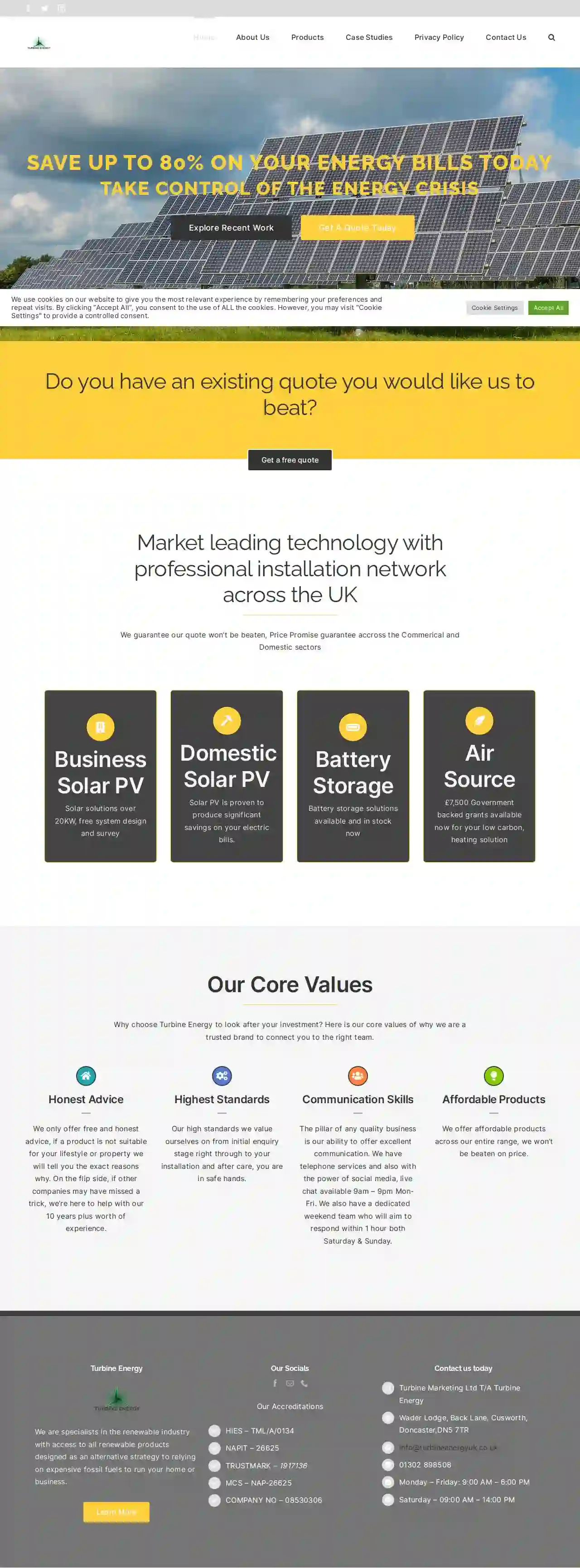Solar Installers Stainforth
Find Solar Energy Companies in Stainforth
Get multiple Solar Installation Companies quotes for your project today! Compare profiles, reviews, accreditations, portfolio, etc... and choose the best deal.

Solarion Solar Energy
32 reviews15 Hampole Balk Lane, Skellow, DN6 8LF, GBSolarion Solar Energy is a leading provider of solar panel and PV systems for both residential and commercial properties in Yorkshire. With over a thousand installations completed, we have a proven track record of delivering high-quality, reliable solar energy solutions. We are experts in solar panel system design and installation, and we can help you save money on your energy bills, reduce your carbon footprint, and take control of your power costs. Our team of experienced designers and installers uses only the best solar panel products from leading manufacturers in the UK and beyond. We offer a wide range of solar panel options to suit every home and business, and we can tailor a system to meet your specific needs and budget. Whether you're looking to reduce your energy bills, protect yourself from rising electricity prices, or simply want to do your part for the environment, Solarion Solar Energy can help. We offer flexible and transparent pricing, and we make the process of going solar as easy as possible. Contact us today for a free consultation and let us show you how solar energy can benefit you.
- Services
- Why Us?
- Gallery
Get Quote
J. H Electrical & Solar Ltd
52 reviewsDoncaster, GBJ.H Electrical and Solar are renewable technology specialists with over 15 years of experience based in the north of England. We understand that choosing a company to help with your journey towards cleaner and more sustainable energy can be a challenging but very important decision. That's why we make sure it's the best decision you make. We install the latest renewable technologies that aim to not only lower your carbon footprint and help the environment, but also lower your electricity consumption and save you money on rising energy prices. Our 3 Step Process To Save You Money 1. **Register Your Interest:** Once you've registered your details, let our friendly customer service team provide you with an energy saving estimate. 2. **Book Your Home Survey:** Our professional surveyors will carry out a home survey to make sure everything is suitable for installation. 3. **Installation Day:** Sit back, relax and let us take care of your installation. Our experienced team will handle everything from install to handover whilst you begin your energy saving journey.
- Services
- Why Us?
- Gallery
Get Quote
Turbine Energy
4.113 reviewsWader Lodge, Back Lane, Cusworth, Doncaster, DN5 7TR, GBTurbine Energy is a specialist renewable energy company based in Doncaster, UK. They offer a range of services including domestic and commercial solar PV, air source heat pumps, and battery storage solutions. With over 10 years of experience, Turbine Energy prides itself on providing honest advice, high standards, excellent communication, and affordable products. They are committed to helping customers reduce their energy bills and transition to a more sustainable future. Turbine Energy is accredited by HIES, NAPIT, TRUSTMARK, and MCS, ensuring quality and reliability.
- Services
- Why Us?
- Accreditations
- Gallery
Get Quote
iVoltz Limited
4.911 reviewsUnit 1A Marrtree Business Park, Doncaster, DN2 4BQ, GBWelcome to IVoltz.com We're thrilled to have you here and thank you for visiting our website. At IVoltz, we are dedicated to powering a brighter future. Whether you are a potential customer, a partner, or simply curious about our innovative solutions, we have something special to offer you. Explore our website to discover the latest in cutting-edge technology, innovative energy solutions, and sustainable power solutions. Our commitment to quality and excellence is reflected in every aspect of our work, and we're eager to share our journey with you. As you navigate through our site, you'll find detailed information about our products and services, our mission and values, and the impact we're making on the world. Feel free to get in touch with us if you have any questions, need further information, or want to explore potential collaborations. Welcome aboard, and let's embark on this electrifying journey together!
- Services
- Why Us?
- Gallery
Get Quote
Green Building Renewables | Solar Panels & Air Source Heat Pumps
4.97 reviewsDunnington, York, Unit 9 Chessingham Park, YO19 5SE, GBGreen Building Renewables is a trading name of GoEco Renewables Limited. We are a leading provider of renewable energy solutions, including solar panels, air source heat pumps, ground source heat pumps, underfloor heating, and electric vehicle charging. Our team of experts is dedicated to helping homeowners and businesses reduce their carbon footprint and save money on their energy bills. With a wide range of products and services, we can help you achieve your sustainability goals. Contact us today to learn more and get a free quote.
- Services
- Why Us?
- Accreditations
- Gallery
Get Quote
Snug Energy Ltd
4.329 reviewsKirk Sandall Industrial Estate, Century Close, Doncaster, DN3 1QR, GBSnug Energy is a leading provider of solar PV and boiler installation services. With a team of experienced professionals, we offer a range of services including solar panel installation, boiler servicing, and power flushing. Our mission is to provide our customers with high-quality, reliable, and affordable solutions that meet their energy needs. With a focus on customer satisfaction, we strive to deliver exceptional service and support every step of the way.
- Services
- Why Us?
- Accreditations
- Our Team
- Testimonials
- Gallery
Get Quote
FEC RENEWABLES LTD
4.827 reviewsDoncaster, GBAt FEC Renewables, we understand that your energy needs are unique, and that's why we provide tailored solar panel installation solutions that work specifically for you. As a leading solar panel installer in Doncaster, South Yorkshire, we have the expertise, experience and resources to design, install and maintain top-quality solar panels that are guaranteed to meet your energy needs and save you money. Our team of skilled and experienced installers are dedicated to providing you with the best possible solutions that fit your specific energy needs. We use only high-quality and reliable solar products that are designed to last and provide you with top performance for years to come. Whether you need solar panels for your home or your business, we have a solution for you. We use only the latest technology and techniques to ensure that you get the most efficient and effective solar panel system possible. And because we are committed to providing you with the best possible service, we offer competitive pricing that won't break the bank.
- Services
- Why Us?
- Accreditations
- Testimonials
- Gallery
Get Quote
Solar 365 Ltd
4.931 reviewsRoom FF00, Oxford House, Sixth Avenue, Doncaster, DN9 3GG, GBSOLAR 365 is a leading solar energy specialist in Yorkshire, UK, dedicated to providing high-quality solar panel installations for homes and businesses throughout the country. With over 15 years of combined experience, our team of experts offers a comprehensive range of services, from initial consultations and system design to installation and after-sales care. We are committed to delivering exceptional customer service and ensuring that our clients benefit from the long-term financial and environmental advantages of solar energy. Our services are available across Yorkshire, including Doncaster, Worksop, Retford, Gainsborough, Brigg, Hessle, Scunthorpe, Goole, Thorne, Pontefract, Castleford, Wetherby, Wakefield, Leeds, Huddersfield, Durham, Lincolnshire, Lancashire, South Yorkshire, Nottinghamshire, Derbyshire, and the rest of the UK.
- Services
- Why Us?
- Accreditations
- Testimonials
- Gallery
Get Quote
Helix Solar
Greyfriars House, Sidings Court, Doncaster, DN4 5NU, GBAt Helix Solar Ltd we pride ourselves on offering innovative and collaborative renewable technology solutions that fit the specific needs of your business. We work directly with UK businesses, large and small, providing tailor-made cost-effective solutions to assist businesses in reducing energy consumption and carbon emissions. We offer an end-to-end service from initial feasibility studies to installation and commissioning.
- Services
- Why Us?
- Gallery
Get Quote
Amco Renewables
53 reviewsBarnsley, GBAmco and Janico have been providing electrical, heating, and plumbing wholesale services for over 40 years, starting as a small family business in York in 1972 and in Retford in 1985. You can find out more about us here. At Amco & Janico, our product knowledge and connections to the right suppliers, bring you the best security solutions. Our Barnsley, Retford & York branches have a bathroom showroom, with the primary showroom located in Retford. We are proud members of the AIEW Buying Group.
- Services
- Why Us?
- Gallery
Get Quote
Over 3,485+ Solar Companies registered
Our solar providers operate in Stainforth and surroundings!
SolarCompaniesHub has curated and vetted Top Solar Installers in Stainforth. Find a trustworthy business today.
Frequently Asked Questions About Solar Installers
- Tax Credits: Reduce your income tax liability based on the cost of your solar system.
- Rebates: Direct cash payments or discounts on the purchase of a solar energy system.
- Net Metering: Allows you to sell excess solar electricity back to the grid for credits.
- Renewable Energy Certificates (RECs): Tradeable credits representing the environmental attributes of your solar energy generation.
Are there any financial incentives for going solar?
Can I go completely off-grid with solar panels?
What happens to my solar panels during a power outage?
Do I need planning permission to install solar panels in UK?
Are there any financial incentives for going solar?
- Tax Credits: Reduce your income tax liability based on the cost of your solar system.
- Rebates: Direct cash payments or discounts on the purchase of a solar energy system.
- Net Metering: Allows you to sell excess solar electricity back to the grid for credits.
- Renewable Energy Certificates (RECs): Tradeable credits representing the environmental attributes of your solar energy generation.